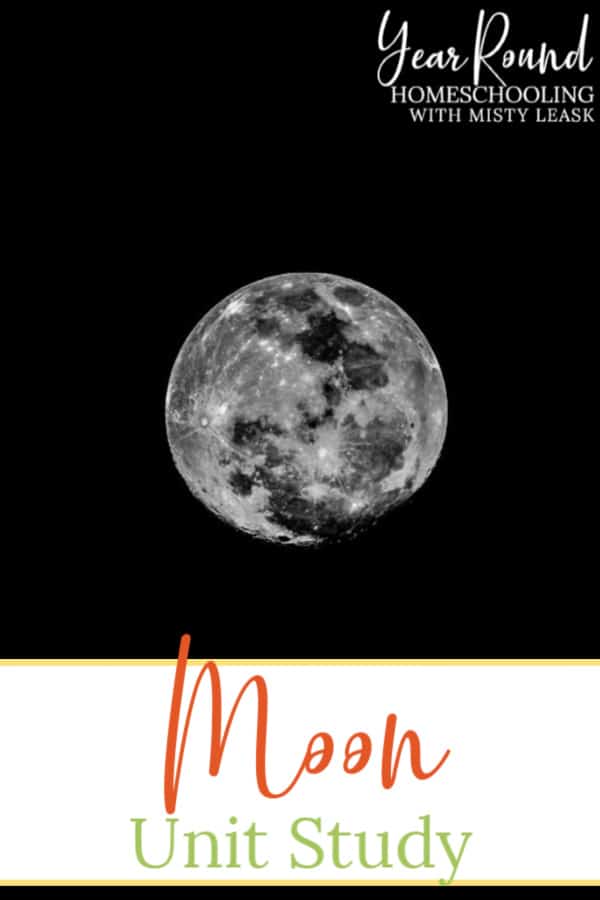The Moon is the most recognized object in our night sky. It is beautiful and provides light in the midst of utter darkness. This Moon unit study will teach your children about the Moon in fun and educational ways.

When my children were young, they were part of the Awana program at our church. At night driving home, we would sing a song when the Moon was out. “I see the Moon and the Moon sees me. The Moon sees someone that I’d like to see. God bless the Moon and God bless me and God bless my entire family.”
At one point, we used to name specific family members rather than ‘my entire family’, but as Aunts, Uncles and Cousins grew, it became harder to name everyone. Living far away from family can be extremely challenging, but this simple song made everyone feel just a little bit closer.
The Moon is pretty far away, even though it is the Earth’s nightlight. Perhaps, this Moon unit study will make it feel a little closer to home and a bit more special to your kids.
Moon Unit Study
Moon
The Earth’s Moon is the only place in the solar system that human life has been outside of our planet. Man’s first visit to the Moon happened on July 20, 1969, when Neil Armstrong and Buzz Aldrin visited.
The moon is important to life on Earth because it balances our planet on its axis. It is also the reason that we have tides on Earth. Without the Moon’s exact place in the solar system, planet Earth would be off its rocker and tides wouldn’t happen.
While we have already visited the Moon, there are currently a few spacecraft exploring the brightest and largest object in our night sky. In total, the Moon has been visited by 24 people, 12 moonwalkers and 100+ robots over the years.
The Moon is a terrestrial body like Venus, Earth, Mercury and Mars. To be “terrestrial” it means that the Moon and these planets are mostly made of rock and metal.
- Name
While all the planets in our solar system have interesting names, the Moon is just that, the Moon. Our moon doesn’t have a specific name because when it was discovered by Galileo Galilei, it was thought to be the only moon in the solar system.
Since we have discovered other moons in the Galaxy, it is important to capitalize Moon when speaking of the Earth’s satellite to differentiate which moon you are referencing.
- Size
Our Moon is the 5th largest moon in the solar system.
-
- Radius
The Moon’s radius is 1,079.6 miles. That means it is less than 1/3 of the width of Earth!
-
- Diameter
The diameter of the Moon is found by multiplying its radius by 2. Which means the Moon’s diameter is 2,159.2 miles.
-
- Mass
The Moon’s mass is only 1.2% of the Earth’s mass at 7.347 x 1022 kg. You would need 80+ objects of the Moon’s mass size to equal the mass of Earth.
-
- Volume
The volume of the Moon is 21.9 billion cubic km, which is equal to approximately 2% of the Earth’s volume.
-
- Surface area
How many square units do you think you’d need to cover the Moon? To find the surface area of an object, you need to determine how many square units would cover it. The Moon’s surface are is 14,647,439.75 square miles.
-
- Density
The Moon’s density is a rather low one at 3.3 g/cm3, making it the 2nd densest moon in the solar system.
- Location in the Solar System
The location of the Moon is always next to the Earth, which is the 3rd planet from the Sun.
- Distance from the Sun
The Moon is 150 million km from the Sun on average.
- Distance from Earth
You could place 30 Earths between the Earth and the Moon! It is on average 238,855 miles away from Earth.
- Layers
The Moon has 3 layers; a core, a mantle and a crust.
The inner core is made of solid iron and is 149 miles in radius. It is covered by a liquid iron shell that is 56 miles thick, followed by a 93-mile thick partially molten layer.
The mantle begins where the Moon’s partially molten layer ends to the bottom of its crust. It is likely to be made of minerals like pyroxene and olivine.
The Moon’s crust differs in thickness based on which side you are on. The near-side of the Moon’s hemisphere has a thickness of about 43 miles while the far-side of the Moon is 93 miles thickness. The crust of the Moons is made of silicon, iron, magnesium, oxygen, calcium and aluminum, with small amounts of thorium, titanium, uranium, potassium and hydrogen.
- Temperature
Temperatures on the Moon tend to be severe and change depending on where the Sun is in relation to the Moon. Half of a month on Earth, the Sun doesn’t shine on the Moon, while the other half of the month it does. When the Sun is shining on the Moon temperatures can rise to 260 degrees Fahrenheit. When the Moon doesn’t have the Sun shining on it, the temperatures can be as low as -387 Fahrenheit, making it the coldest place in the solar system!
- Orbit
The Moon orbits around the Earth as approximately 2,288 miles per hour!
- Axis Rotation
It takes 27 Earth days for the Moon to travel around the Earth. Since the Earth is always moving it appears that it takes the Moon 29 days to travel around us.
- Atmosphere
The Moon’s atmosphere is called an exosphere and it is fragile and weak. Due to the fact that the exosphere is thin and weak, it doesn’t provide any protection from the radiation of the Sun or impacts from meteoroids.
- Phases of the Moon
At different times of the month, the moon looks different. That’s because the moon doesn’t actually shine on us, it reflects light. How it reflects light back to earth depends on where the sun is shining on the moon.
There are 8 different phases of the moon; new moon, waxing crescent, first quarter, waxing gibbous, full moon, waning gibbous, third quarter and waning crescent. A full cycle of the moon’s phases happens every 29.6 days or once a month.
- Lunar Eclipse
A lunar eclipse occurs when the Earth goes between the Sun and the Moon. This causes the Sun to not be able to shine on the Moon. There are two types of lunar eclipses; a total lunar eclipse and a partial lunar eclipse. The first happens when the Earth is directly between the Moon and the Sun. The latter takes place when the Moon is covered partially by our home planet, Earth’s shadow.
Please note, that some of the resources below may include evolutionary information. I encourage you to have a conversation with your children or preview these resources prior to assigning them as part of your homeschool studies.
Articles
Literature
Our Created Moon
 Moon! Earth's Best Friend (...Shop on Amazon
Moon! Earth's Best Friend (...Shop on Amazon Moon: A Peek-Through Pictur...Shop on Amazon
Moon: A Peek-Through Pictur...Shop on Amazon The Moon Book: Fascinating ...Shop on Amazon
The Moon Book: Fascinating ...Shop on Amazon So That's How the Moon Chan...Shop on Amazon
So That's How the Moon Chan...Shop on Amazon Many Moons: Learn about the...Shop on Amazon
Many Moons: Learn about the...Shop on Amazon The Moon Book (New & Update...Shop on Amazon
The Moon Book (New & Update...Shop on Amazon Moon, Gorgeous MoonShop on Amazon
Moon, Gorgeous MoonShop on Amazon The Faces, or Phases, of th...Shop on Amazon
The Faces, or Phases, of th...Shop on Amazon Apollo Expeditions to the M...Shop on Amazon
Apollo Expeditions to the M...Shop on Amazon My Little Golden Book About...Shop on Amazon
My Little Golden Book About...Shop on Amazon Moon: From Ancient Myths to...Shop on Amazon
Moon: From Ancient Myths to...Shop on Amazon Hello, World! Moon LandingShop on Amazon
Hello, World! Moon LandingShop on Amazon 50 Things to See on the Moo...Shop on Amazon
50 Things to See on the Moo...Shop on Amazon The MoonShop on Amazon
The MoonShop on Amazon The Moon Seems to Change (L...Shop on Amazon
The Moon Seems to Change (L...Shop on Amazon Moonwalk: The First Trip to...Shop on Amazon
Moonwalk: The First Trip to...Shop on Amazon Smithsonian Kids: To the Mo...Shop on Amazon
Smithsonian Kids: To the Mo...Shop on Amazon
Videos
Art
Moon Phases Glue Resist Watercolor Painting
Crafts
Tin Foil Moon
Games and Activities
Moon Crafter Gross Motor Activity
Gross Motor Moon Phases Activity
Preschool Moon Observation Form
Printables
Montessori Moon Printable Pack
Food
Learning about the Moon opens up a whole new world — a place beyond our home that man has stepped foot onto. You just might see or hear new dreams your kids have after completing this unit study!
What did your kids enjoy learning the most through your Moon unit study?
